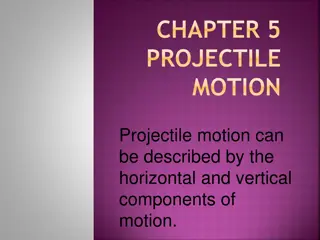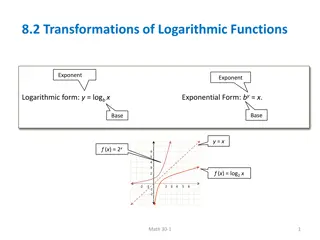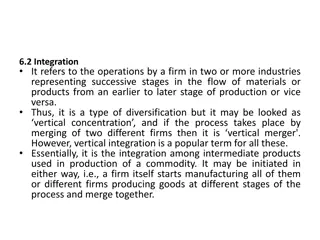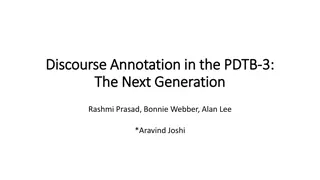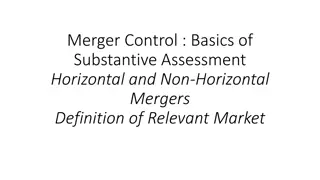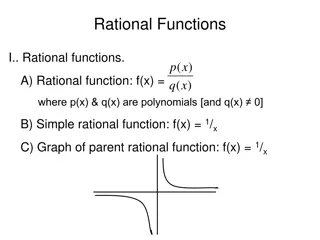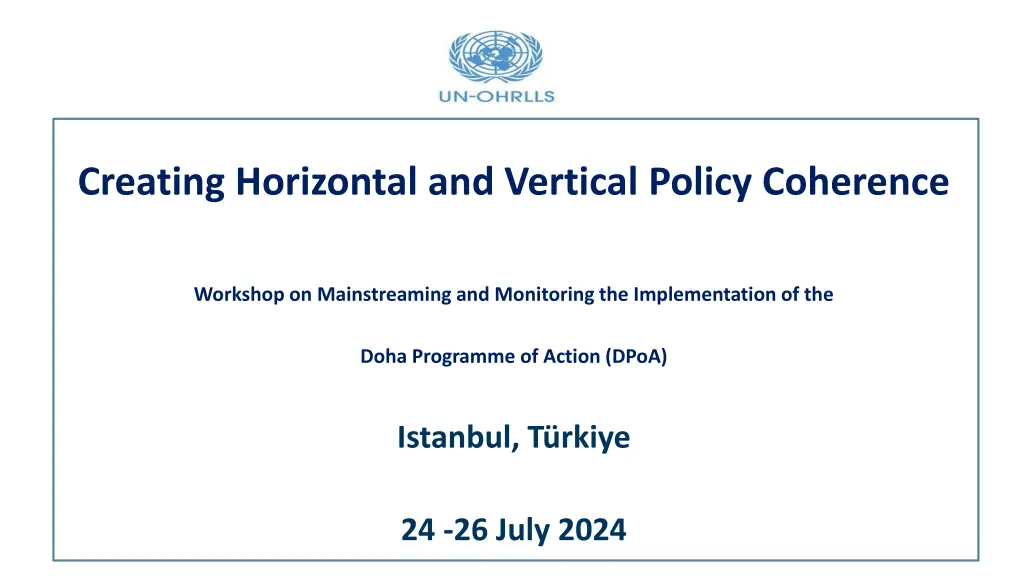
Policy Coherence Workshop on Implementing the Doha Programme of Action
Explore the importance of horizontal and vertical policy coherence in mainstreaming and monitoring the Doha Programme of Action (DPoA) through formal partnerships and integration. Learn how to ensure alignment with national development plans and global commitments for enhanced effectiveness and resilience.
Download Presentation

Please find below an Image/Link to download the presentation.
The content on the website is provided AS IS for your information and personal use only. It may not be sold, licensed, or shared on other websites without obtaining consent from the author. If you encounter any issues during the download, it is possible that the publisher has removed the file from their server.
You are allowed to download the files provided on this website for personal or commercial use, subject to the condition that they are used lawfully. All files are the property of their respective owners.
The content on the website is provided AS IS for your information and personal use only. It may not be sold, licensed, or shared on other websites without obtaining consent from the author.
E N D
Presentation Transcript
Creating Horizontal and Vertical Policy Coherence Workshop on Mainstreaming and Monitoring the Implementation of the Doha Programme of Action (DPoA) Istanbul, T rkiye 24 -26 July 2024
GUIDANCE AREA 4. CREATING HORIZONTAL AND VERTICAL POLICY COHERENCE
Coverage UNCTs Support Checklist for Vertical Policy Coherence DPoA Issues in Planning Guidelines Checklist for Horizontal Policy Coherence Guidance and Experiences Purpose
Purpose Purpose - - Horizontal Policy Coherence Horizontal Policy Coherence Horizontal policy coherence is the creation of formal partnerships between ministries and agencies that operate in different sectors to ensure that proposed policies, programmes, and targets align with nationally tailored DPoA actions. Coherence between a national development plan on one hand, and the other multiple development commitments and initiatives that countries have signed on. Integration Partnerships (National Level)
Purpose - Horizontal Policy Coherence LDCs are to use planning, reporting, and monitoring systems to ensure coherence between the DPoA and other global processes or international commitments Addis Ababa Action Agenda 2030 Agenda DPoA - integrated NDP Paris Agreement Sendai Framework 5
Purpose Purpose - - Vertical Policy Coherence Vertical Policy Coherence Partnerships among governments, the business sector, civil society, and other players at national and subnational levels. The process of enhancing efficiency and resilience in multi-tiered systems. Localization of the DPoA is crucial if the DPoA priorities are to be met by 2031. DPoA Localization Partnerships (National, Subnational and local Level)
Purpose Purpose - - Vertical Policy Coherence Vertical Policy Coherence Partnerships among governments, the business sector, civil society, and other players at national and subnational levels. To further encourage better territorial cohesiveness, more integration between urban and rural areas must be encouraged. DPoA Localization Partnerships (National, Subnational and local Level)
Guidance and Experiences Guidance and Experiences Horizontal policy coherence, integration, and partnerships can be achieved through: Integrated policy analysis: to guarantee that proposed policies, programmes, and targets support the DPoA. Coordinated institutional mechanisms: to establish formal partnerships across sectoral line ministries and agencies.
Guidance and Experiences Guidance and Experiences Vertical policy coherence calls for the following: Institutional mechanisms for coordination: to promote collaboration and coordination between governmental levels. DPoA localization and networking Integrated modeling: to investigate the effects and advantages of important national policies and initiatives at the local and subnational levels.
Checklist for Horizontal Policy Coherence Have Ministries, Departments, and Agencies at the national level incorporated DPoA priorities into their strategic and sectoral plans? Has the role of the private sector, civil society organizations, bilateral and multilateral donors, and other stakeholders in supporting the implementation of DPoA been considered in the National Development Plan? Has the role of parliament in implementing the DPoA been considered in the National Development Plan?
Checklist for Horizontal Policy Coherence How do the planned policy outputs in the National Development Plans/budgets contribute to achieving the DPoA priorities? Have formal mechanisms been established for inter-ministerial collaboration, and coordination on the DPoA priorities? Is the budget process used to set priorities, reconcile policy objectives, and promote policy integration?
Checklist for Vertical Policy Coherence Has the DPoA priorities been mainstreamed into sub-national plans? Has the role of subnational and local governments, and municipalities been considered in the National Development Plan? Has the government involved local stakeholders in the formulation and implementation of national policies? Is the national government supporting local authorities to increase or combine resources and capacities to formulate effective policy responses for DPoA implementation?
Checklist for Vertical Policy Coherence Are implementation responsibilities of the DPoA priorities clearly divided among different levels of government, considering the distinct competences and comparative advantage of each level? What mechanisms are in place to ensure coordination and joint action of agencies from different government levels involved in international initiatives? Are there specific mechanisms to ensure effective feedback between different levels of government?
DPoA in the Medium-Term Development Planning Process (Planning Guidelines) The DPoA priorities are to be considered in the preparation of the Guidelines for preparing the National, Regional, Subnational, and Local Plans.
UNCTs Support in Horizontal and Vertical Coherence UNCTs Support in Horizontal and Vertical Coherence The UNCTs in LDCs should collaborate with governments to identify and address development challenges in LDCs using cross-sectoral analysis. This means more money is available for lending which reduces interest rates businesses borrow for investment, The demand for goods and services in the UK increases. consumers borrow for consumption (housing) This leads to more jobs.
UNCTs Support in Horizontal and Vertical Coherence UNCTs Support in Horizontal and Vertical Coherence To implement integrated methods for the DPoA, including policy design, technical analysis, and strategic priority setting. The UNCTs in LDCs should collaborate with governments to identify and address development challenges in LDCs using cross-sectoral and systems- thinking methods which reduces interest rates businesses borrow for investment, The demand for goods and services in the UK increases. consumers borrow for consumption (housing) This leads to more jobs.
UNCTs Support in Horizontal and Vertical Coherence UNCTs Support in Horizontal and Vertical Coherence The UNCTs in LDCs should collaborate with governments to identify and address development challenges in LDCs using cross-sectoral and systems- thinking methods To implement integrated methods for the DPoA, including policy design, technical analysis, and strategic priority setting. They can help LDCs achieve vertical policy coherence by exploring emerging good practices and practical learnings. businesses borrow for investment, The demand for goods and services in the UK increases. consumers borrow for consumption (housing) This leads to more jobs.
UNCTs Support in Horizontal and Vertical Coherence UNCTs Support in Horizontal and Vertical Coherence To implement integrated methods for the DPoA, including policy design, technical analysis, and strategic priority setting. The UNCTs in LDCs should collaborate with governments to identify and address development challenges in LDCs using cross-sectoral and systems- thinking methods They can help LDCs achieve vertical policy coherence by exploring emerging good practices and practical learnings. Support research on vertical coherence processes under the DPoA. The demand for goods and services in the UK increases. This leads to more jobs.
UNCTs Support in Horizontal and Vertical Coherence UNCTs Support in Horizontal and Vertical Coherence The UNCTs in LDCs should collaborate with governments to identify and address development challenges in LDCs using cross-sectoral and systems- thinking methods To implement integrated methods for the DPoA, including policy design, technical analysis, and strategic priority setting. They can help LDCs achieve vertical policy coherence by exploring emerging good practices and practical learnings. Support research on vertical coherence processes under the DPoA. Support case studies to translate lessons into good practices for decision- makers in LDCs.
Interactive Discussion Horizontal and Vertical Policy Coherence Despite the many examples of public policies, plans, and strategies developed in the past to address development issues in an LDC, the development planning and implementation terrain is confronted with several challenges. There are policy conflicts, inconsistencies, and duplications at the ministries, departments, and agencies. The ministries, departments, and agencies, as well as key stakeholders such as the private sector and non- governmental decision-makers at national and subnational levels, have not incorporated DPoA priorities into their strategic and sectoral plans. There is no mechanism to ensure effective feedback between different levels of government. Suggest concrete policy actions to minimize these weaknesses and challenges. Guiding Questions 1. What measures can be taken to ensure coordination at the national level and to prevent ministries, departments, and agencies from working in silos? 2. How can the DPoA priorities be integrated into subnational plans? 3. What mechanisms can be used to ensure effective feedback across the different levels of government?



